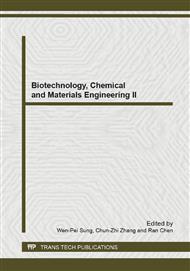p.606
p.615
p.619
p.625
p.630
p.638
p.645
p.654
p.666
Bioinformatics Analysis and Characteristics of Capsular Exopolysaccharide Family Gene and its Encoding Protein in Riemerella Anatipestifer
Abstract:
To provide some evidence for further research on the biological function of capsular polysaccharide family gene and its endcoding protein of Riemerella anatipestifer.we analyzed the sequence of capsular exopolysaccharide gene and physicochemical properties , structure , function of capsular exopolysaccharide family protein by bioinformatics tools online.We found that capsular exopolysaccharide family gene is an open reading frame with 2373 bp in length and contained a single ORF, which consisted of 732 adenine,443 cytosine,321 guanine,877 thymine and a GC content 32.20%. The NC value of the nucleotides sequence of capsular exopolysaccharide family gene was 44.270. Capsular exopolysaccharide family protein consisted of 790 amino acids and had the following characteristics: numerous highly hydrophilic region, two transmembrane domains, zero signal peptide cleavage site, numerous functional sites. We obtain more biological information about capsular exopolysaccharide family gene and its endcoding protein by bioinformatic analysis, which provide some basic information for further research.
Info:
Periodical:
Pages:
630-637
Citation:
Online since:
January 2013
Authors:
Price:
Сopyright:
© 2013 Trans Tech Publications Ltd. All Rights Reserved
Share:
Citation:


